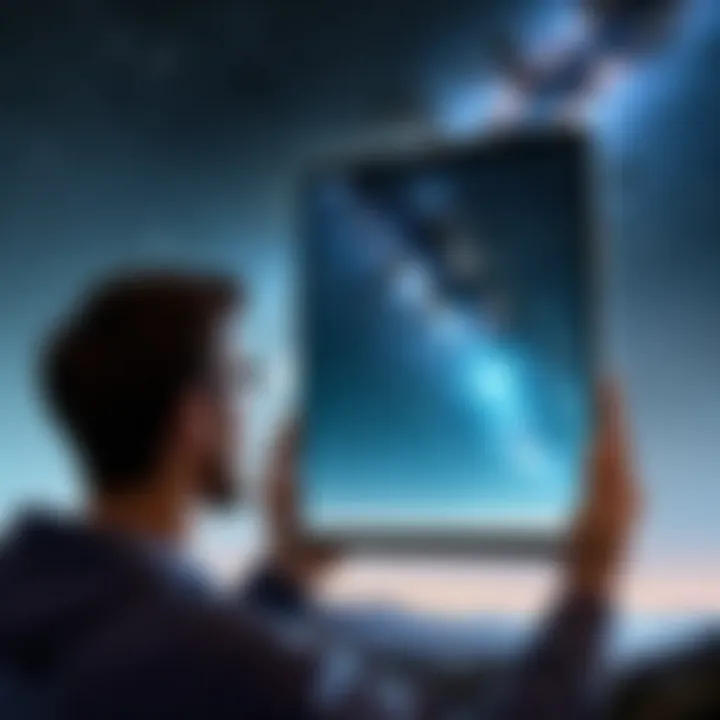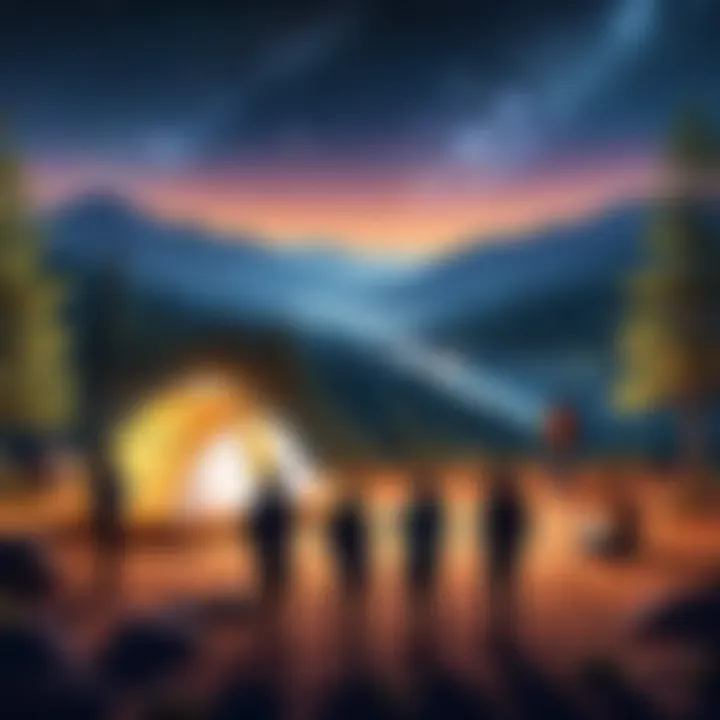Exploring the Rise of Star Recognition Applications


Intro
In recent years, the landscape of stargazing has transformed dramatically, largely due to technological advancements. Star recognition applications are at the forefront of this evolution. They allow users to identify celestial bodies, understand constellations, and enhance their overall experience of the night sky. This guide provides an in-depth look at star recognition applications, with a focus on software characteristics, user experience, potential advantages, and limitations.
Software Overview
Star recognition apps have a broad array of features. The fundamental functionalities include image recognition of stars and constellations, along with informative descriptions and statistics about the celestial entities identified. These applications often enable the user to engage with augmented reality. They allow stargazers to point their devices at the sky and receive instant feedback on visible stars, planets, and other celestial objects.
Features like offline mode, contribution to community projects, and integration with social media enhance the user experience. Pricing models in this domain vary significantly; many apps offer free versions with limited features, while premium versions include comprehensive databases and advanced capabilities, priced around $5 to $20 per year. Ensuring compatibility, most of the widely used applications, such as SkySafari, Stellarium, and Star Walk 2, support popular platforms such as iOS and Android.
User Experience
User experience is crucial for the success of star recognition applications. An intuitive interface facilitates ease of use. Applications that prioritize clean layout and ease of navigation provide seamless experiences, helping both novices and seasoned astronomers engage meaningfully with the night sky.
Customizability can also enhance user satisfaction. Features allowing configuration of settings based on location, intensity of light, or personal preferences appeal to a wide range of users. Performance is equally important; high-speed processing and low lag time enrich user interaction and enhance overall satisfaction.
Pros and Cons
Evaluating strengths offers valuable insight into each application's utility. Advantages often include vast databases of celestial objects, community-driven improvements, and educational elements that cater to different user types.
However, there are drawbacks. Issues like dependency on location services can deter some users. Then there are occasional inaccuracies in identification, particularly in areas with significant light pollution or obstructions. To discern differences, applications must be evaluated against each other carefully. For example, Star Walk 2 excels in its user interface, while Stellarium stands out in its realism.
Real-world Applications
The industry-specific applications of star recognition software soar beyond just casual use. Educational institutions might employ these apps to enhance astronomy curricula, engaging students in interactive learning. Moreover, amateurs and professional astronomers utilize these tools to identify celestial phenomena and keep meticulous observation records.
Success stories are prevalent. A small observatory implemented SkySafari and noted an uptick in public outreach visits, enabling visitors to accurately track celestial events. These narratives emphasize how crucial star recognition apps can be in broadening public engagement with astronomy and science.
Updates and Support
Star recognition applications face the continuous challenge of keeping the user engaged post-download. Frequent updates are essential for sustaining user interest. Some apps regularly integrate updates that refresh their databases and tweak performance.
Customer support is tailored largely through community forums and dedicated support channels. User resources often range from helpful articles and video guides to active engagement communities on platforms such as Reddit.
Regular updates and effective support channels greatly enhance the reliability of star recognition applications, improving user trust and interaction by ensuring they remain up-to-date with celestial happenings.
By understanding star recognition applications from these angles, both enthusiasts and professionals can make informed choices suited to their unique preferences and requirements.
Prelims to Star Recognition Apps
Star recognition applications have transformed the way we engage with the night sky. Depending on advancements in technology and growing accessibility of knowledge, these apps blend astronomy and practical usability, thus revolutionizing stargazing experiences. Users range from amateur enthusiasts absorbing vast amounts of information to professional astronomers conducting expansive research. This diversity underscores the evolving role of star recognition technology beyond just identification and into experiential enhancement.
This section engages with two critical aspects:
Defining Star Recognition Technology
Star recognition technology refers to the various mechanisms used within mobile applications and software programs to identify stars, constellations, and celestial phenomena. Primarily, these technologies involve a combination of image recognition, database access, and extraction of relevant astronomical data based upon user input. A significant portion hinges on real-time device orientations, thus facilitating intuitive interaction with nighttime objects. Users can point their devices at the sky, deploy the app, and instantly receive names and details of celestial entities.
Market trends suggest that a seamless integration of user-friendly interfaces and cutting-edge algorithms keeps these apps increasingly relevant. For instance, it engages users by offering interactive educational content, enriching their overall stargazing journey.
Historical Context and Evolution
The roots of star recognition applications can be traced back to traditional astronomy practices. Early astronomers relied on charts and more manual methods to navigate the cosmos. As technology progressed, these techniques did not entirely become obsolete but gradually integrated electronic predictive data methodologies. With the inception of personal devices like smartphones, the possibilities for wider applications emerged radically. Augmented with satellite imagery and mobile technology, star recognition software began developing and evolved into user-centric applications, marking an era of easy access to astronomical information.
The transition became evident as more sophisticated features, such as augmented reality overlays, were introduced. This allowed users to see the constellations superimposed onto their device’s screen against the backdrop of their real environment. Such progress invites further deliberation on the future of astronomy as we understand it today, making the night sky more approachable than ever.


In essence, star recognition applications reflect both technical evolution and social engagement, promoting scientific literacy among users of all ages.
Understanding these developments paves the way for grasping their current and future impacts on social, educational, and professional spheres.
How Star Recognition Apps Work
Understanding how star recognition apps operate is essential in appreciating their role in astronomy and leisure activities alike. These applications leverage a blend of advanced technology, user-friendly interfaces, and sophisticated algorithms. This interplay transforms star gazing from a complex task into an accessible experience for users of diverse backgrounds.
Fundamental Technologies Used
Image Processing
Image processing plays a critical role in star recognition apps. It involves the manipulation and analysis of images taken from telescopes or smartphone cameras. The key characteristic of image processing in this context is its ability to enhance and filter images. This allows for better identification of stars and celestial objects, making it a popular feature in many applications.
A unique feature of image processing is its capacity to align and compare images taken at different times. This can greatly enhance the accuracy of star positioning and recognition. However, one disadvantage is its reliance on camera quality; low-resolution images may hinder results.
Database of Celestial Objects
The database of celestial objects is a fundamental component of star recognition apps. These databases contain vast information on various stars, galaxies, and other celestial elements. The key characteristic here is the depth and accuracy of data available, which supports users in identifying specific objects as they gaze at the night sky.
These databases often get frequently updated with new discoveries which ensures that users access the most current data available. One unique feature is the ability to include metadata, such as brightness or distance, adding to the educational aspect. However, the main disadvantage could be the size of the database that might lead to longer loading times when fetching extensive data.
Machine Learning Algorithms
Machine learning algorithms significantly elevate user experience in star recognition apps. They analyze patterns from a vast array of data inputs, helping the app to recognize stars and objects autonomously. The key characteristic of these algorithms lies in their adaptability. The more users engage with the app, the more accurate the recognition becomes.
A unique capability of machine learning algorithms within these apps is their potential for predictive functions. For example, an app may suggest which stars to observe based on time of year and user behavior. An important disadvantage, though, could be the requirement of substantial data and processing power which might limit usage on older devices.
User Interfaces and Experience
Design Principles
Design principles in star recognition apps can greatly influence user engagement and learning. Simplicity and clarity are vital, allowing users to focus on the stars rather than navigating complicated tools. An important benefit of a streamlined design is that it appeals to both amateur and seasoned astronomers alike.
The uniqueness of designing such apps often lies in finding a balance between aesthetics and functionality. While a polished interface enhances the experience, overloaded features may lead to frustration. Thus, understanding user preferences is essential to survival in the competitive app market.
Navigation Features
Navigation features are crucial in ensuring users can access different sections of the app without unnecessary complications. Key abilities like smooth scrolling, intuitive menus, and search functions greatly improve usability. Positive characteristics here are improved satisfaction ratings from users that lead to higher engagement rates.
One particularly unique feature is voice recognition for navigation; this technology allows users to operate the app while engaging in outdoor activities. Still, concerns about connectivity in remote locations may limit reliability, as users look for dependable functionality even under less-than-ideal circumstances.
In the emerging landscape of star recognition, technological integration stands to shape the future. Understanding how these work can help users harness their potential, ensuring smoother experiences while stargazing.
Overall, the technologies and user interfaces discussed above accentuate how much detail and thought underpin the functioning of star recognition apps. This comprehensive examination showcases the intertwining of user experience and technical excellence in these advanced tools.
Top Star Recognition Applications
In the rapidly evolving landscape of digital applications, star recognition technologies present unique utilities for different user bases. This section aims to delve into noteworthy applications available for enthusiasts and professionals alike. Understanding the available options can significantly enhance both educational engagement and experiential design in the realm of astronomy.
Overview of Popular Options
When assessing the market for star recognition applications, a few names surface as leaders, each offering distinctive features:
- Star Walk 2: This application provides an interactive experience, allowing users to point their devices at the sky to identify stars and constellations in real time. Its design is user-friendly, making it accessible for everyone from children to seasoned astronomers.
- SkySafari: A more robust program offering in-depth visualizations of celestial objects, SkySafari includes a rich database. It caters to advanced users seeking a more immersive experience with detailed star maps and simulation tools.
- Stellarium: Known for its extensive open-source attributes, this software can be great for educational purposes. Stellarium is often praised for its accurately rendered cosmic visualization, making it suitable for classrooms and observatories alike.


Comparison of Key Features
To provide clarity, it can be useful to compare the significant aspects of popular star recognition apps based on user ratings, accessibility, and device compatibility.
User Ratings
User ratings serve as a crucial marker reflecting overall satisfaction and app performance. Higher ratings are commonly associated with user-friendly design and comprehensive feature sets.
Notably, both Star Walk 2 and SkySafari consistently receive high marks for ease of use and the enjoyment factor. Engaging interface helps capture interest among casual users and professionals alike.
However, it's also essential to be mindful of nuances in ratings, which may change over time or differ based on device use. Thus, a careful look at recent reviews can provide current perspectives on app performance.
Accessibility
Accessibility in star recognition apps is critical to broadening user bases. The ease with which individuals can download, learn and eventually utilize these applications plays a vital role in their overall reach.
Apps like Stellarium highlight inclusivity—you can access them on a variety of platforms, from desktop to mobile devices. This feature ensures those new to astronomy do not face barriers in understanding star mapping and identification. However, some highly specialized features may remain locked behind premium versions, which can deter users who are hesitant to spend initially.
Device Compatibility
Device compatibility directly influences an app’s usability across different technology ecosystems. A well-optimized application works seamlessly on both Android and iOS platforms, enabling better outreach.
Star Walk 2 demonstrates excellent compatibility, functioning on most mobile devices without the need for regular updates or maintenance issues. On the other hand, applications like SkySafari may require newer operating system versions to maximize performance, potentially excluding users with older devices.
User Testimonials and Reviews
User testimonials provide a genuine window into the functionality and engagement of these applications. Many fans of Star Walk 2 appreciate its interactive approach, allowing for exploration without overwhelming technical jargon. Others using Stellarium praise the educational advantages, particularly how it aids learning through visualization.
Feedback overall highlights both positive experiences and areas for improvement. Many reviews often mention updates added based on user feedback, showcasing developers' commitment to evolving their platforms in response to audience needs and market changes. Having both constructive and complimentary observations contributes to a comprehensive field analysis of the current state of star recognition applications.
This careful consideration of users' voices helps to form a broader narrative around the ongoing impact these technologies enact, hinting at avenues for refinements ahead.
Benefits of Using Star Recognition Apps
Star recognition apps serve as powerful tools in various aspects of life. Their functionalities consistently broaden the users' abilities to not only enjoy but comprehensively learn about the celestial bodies overhead. These apps contribute significantly to both amateur stargazers and professional researchers, and understanding the benefits they provide is crucial in appreciating their value.
Educational Value
The primary educational value of star recognition apps lies in their accessibility to scientific knowledge. They document the positions and characteristics of constellations, stars, and planets. Educational institutions, ranging from elementary schools to universities, can leverage these apps to supplement their astronomy curriculum. For instance, a teacher could employ the App such as Star Walk 2 to engage students actively with the subject matter.
Such an engagement helps in consolidating theoretical knowledge by offering practical experience. Built-in tutorials and easy-to-follow guides foster deeper comprehension of astronomy and physics fundamentals. These platforms encourage active participation, leading to enhanced retention of knowledge. Not only students see the practicality of the subject small businesses can also integrate them in promotional activities that have cosmic themes, captivating audiences' interests from diverse backgrounds.
Enhancing Stargazing Experiences
Star recognition apps genuinely enhance the stargazing experience. Users can open these applications on their mobile devices and point them toward the nighttime sky, receiving immediate information on stars, constellations, and even deep-sky objects such as nebulae. This augmented experience transforms a simple act of looking at stars into an interactive journey through space.
Many apps feature augmented reality that overlays visuals through the camera. This means users can view detailed information about the celestial objects they see, including distance, brightness, and whether they are visible at that specific moment. Applications like SkyView and Night Sky allow users to connect with their surroundings effectively, thus cultivating a more profound appreciation for the universe. This type of immersion encourages casual observers to develop a more scientific consciousness about space.
Professional Applications for Research
Star recognition applications also have substantial implications for professional use in research. Astronomers and astronauts utilize such apps to enhance their observations in real-time. Tools like Stellarium offer simulations that are invaluable, allowing researchers to model and analyze celestial events efficiently. By using these tools, institutionals often gain insights that remain inaccessible by mere observation alone.
Professional collaborations often require precise data. Some apps allow researchers to document their findings, tracking observations over time while linking them to known celestial events. This adds an essential layer of technology-supported resource for further study and citation. Thus, not only individuals but organizations can garner rich information through these applications, saving time and increasing accuracy in their quests to understand cosmic phenomena.
In today’s technological landscape, the profound reach of star recognition apps marks a distinct evolution in both personal engagement and professional inquiry into astronomy.


Challenges Facing Star Recognition Apps
The development and advancement of star recognition applications have undoubtedly brought new horizons to the world of stargazing and astronomical exploration. Yet, these applications are not without their hurdles. Understanding these challenges not only outlines the current landscape but can also guide possible improvements in technology and user experience. This section will address both technical limitations and market dynamics, as these aspects are critical in understanding the challenges star recognition apps face today.
Technical Limitations
Technical limitations stand as a foundational challenge for star recognition applications. These applications rely heavily on image processing technology, database efficiency, and precise algorithms for celestial object classification. In many cases, the quality of image recognition can vary considerably due to factors such as light pollution, camera quality, and atmospheric conditions. The algorithms may struggle to recognize faint celestial bodies when background noise from urban environments is present.
Moreover, the databases used to identify stars and constellations must be both comprehensive and accurate. Many third-party apps use open-source databases, which may lack the depth and reliability needed for professional-grade identification. The performance of machine learning models becomes increasingly complex when various star aspects, such as color, magnitude, and spectral features, are involved. This inconsistency in data quality can skew results, leading to user frustration or misidentification.
Additionally, battery optimization affects the performance of star recognition apps. High-quality image and signal processing demand considerable power, often draining mobile device batteries rapidly. Users frequently complain about the short operational time while using these apps for enthusatic stargazing, essentially limiting their experience.
Market Saturation and Competition
The market for star recognition applications has witnessed significant growth in recent years. As the consumer interest in astronomy has surged, numerous apps have emerged, demonstrating strong features and engaging user interfaces. However, this proliferation creates its own set of challenges, primarily revolving around saturation.
With many choices available, users may feel overwhelmed by options. As a result, the quality of differentiation becomes a critical component. Many star recognition apps can exhibit similar functionalities. This similarity dilutes market shares for both small developers and established brands, straining profit margins.
Consequently, differentiation through feature sets, design, and user engagement is paramount for any aspiring application. New entrants might struggle not just to develop distinctive features, but also to attain visibility among a myriad of similar offerings. Building a loyal user base becomes increasingly expensive due to heightened marketing needs in a crowded marketplace, further stretchinb resources for small developers.
Future Trends in Star Recognition Technology
The conversation about future trends in star recognition technology unveils a critical vantage point on the evolution of this field. With the stir of innovation continuously reshaping how users engage with stars and celestial objects, understanding these trends is vital. As artificial intelligence integrates more seamlessly and robustly into star recognition apps, users can expect greater accuracy in identifying stars and constellations. Inside the app market, the advancement of user experiences and maintenance of data sets support casual activity and professional research alike.
Advancements in Artificial Intelligence
Artificial intelligence is at the forefront of driving improvements in star recognition applications. The algorithms used have matured, providing users with enhanced precision in recognizing celestial entities. The increasing adoption of deep learning methods allows the software to differentiate stars from similar entities with higher reliability.
Moreover, ongoing research into neural networks suggests that the future may hold real-time star identification capabilities. This would empower users to point their device at the sky and instantly receive match results, making the application vastly user-friendly for everyday stargazers and serious astronomy enthusiasts alike.
Potential for Integration with Other Technologies
Virtual Reality
Virtual reality contributes significantly to enhancing star recognition technology. By creating immersive environments, users can engage with the cosmos in a manner previously unseen. This power of interaction opens doors to educational scenarios where learners can visualize and understand celestial pathways clearly. The unique feature here lies in the ability for users to simulate traveling different parts of the universe, allowing deeper exploration beyond mere observation.
Advantages include effective visual engagements and interactive learning that captivates the imagination. However, extensive hardware requirements could limit overall accessibility for many potential users.
Augmented Reality
Augmented reality provides another angle for developing star recognition applications. By overlaying digital information on real-world views, users can see constellations, planets, and other celestial phenomena directly within their physical surroundings. The key characteristic of augmented reality is its real-time information delivery, making it an engaging choice in apps.
Its unique aspect revolves around its ability to use embedded location services, aligning what one see in the sky with machine-generated data. While there are impactful advantages in creating intuitive learning experiences, reliance on GPS accuracy and device capability can impose constraints, limiting breakdown of content that consumer devices manage differently.
In summary, as AI and integration with technologies like virtual and augmented reality progress, users may foresee a significant leap in user interaction and the efficiency of stargazing applications.
The efficiency of star recognition apps depends greatly on the innovation cycle within technology, bridging gaps and enhancing user experience overall.
These future trends illustrate paths where the applications cannot only serve seasoned professionals but also boost the interests of amateurs delving into astronomy. Overall, understanding these movements in technological procedures benefits users and professionals focused in the realm of celestial exploration.
Ending
The significance of star recognition applications extends beyond mere curiosity. These tools facilitate exploration and understanding of the cosmos. The benefits are diverse, catering to both amateurs and experts in astronomy.
Summary of Key Insights
Throughout this article, we have discussed various facets of star recognition applications. Key points include their technical inner workings, advantages in education, enhanced stargazing enjoyment, and their contributions to professional research. The technology behind these applications—ranging from image processing to advanced machine learning algorithms—remains pivotal for their effectiveness. As more users engage with these tools, the demand for accuracy and user-friendly interfaces will only escalate. Challenges such as technical limitations and a saturated market create more compelling avenues for innovation.
Final Thoughts on the Impact of Star Recognition Apps
Star recognition applications play a pivotal role in democratizing access to astronomical knowledge. They have transformed how we view the night sky, fostering interest and educational engagement. The steady integration of these apps with emerging technologies promises even more refined user experiences in the future. Consider incentives for leveraging these findings—social media sharing capabilities or integration with community-driven platforms can amplify the thrill of being a stargazer. As technology continues to evolve, so will the functionality and significance of these applications, shaping a more informed and curious public sphere.



